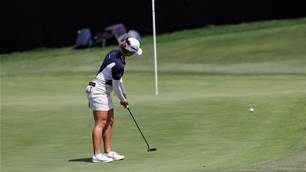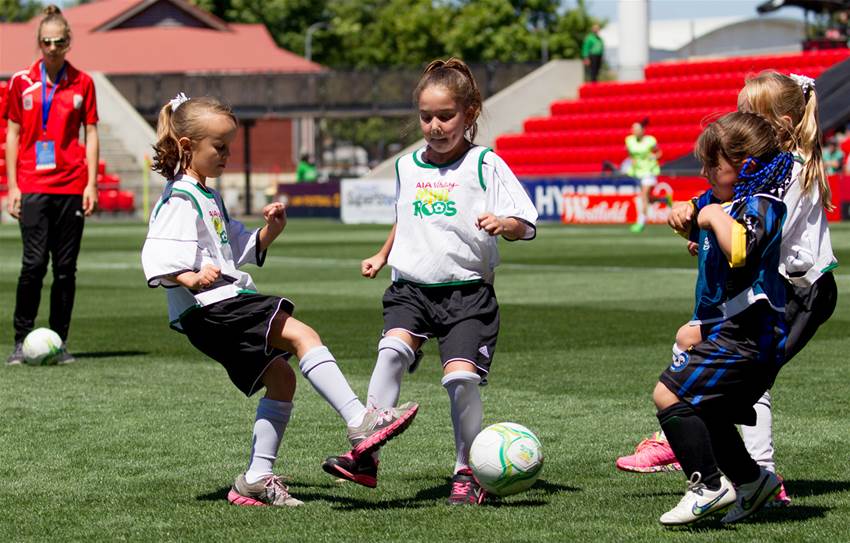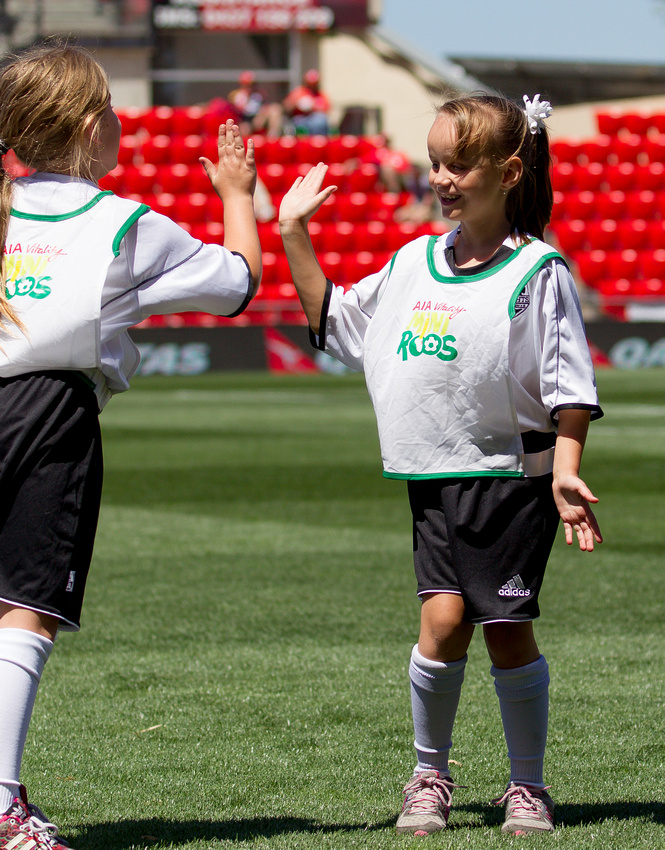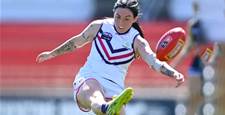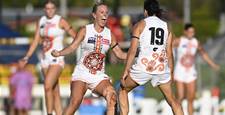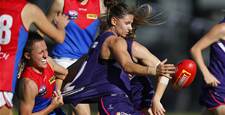It has finally happened.
It has finally happened.
Football has overtaken netball as the number one sport for young Australian girls in the important 6 - 13 age group.
This news comes from respected Australian market research company Roy Morgan Research (RMR), as part of their recent findings from the Roy Morgan Research Young Australians Survey.
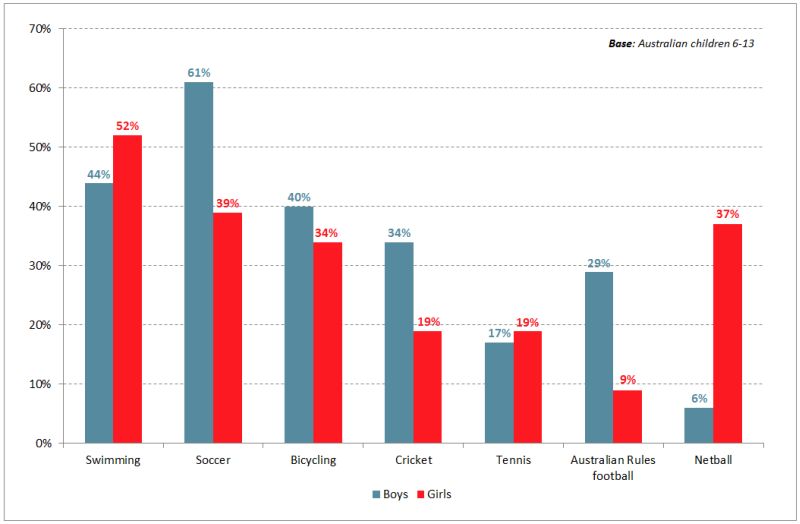 Source: Roy Morgan Research
Source: Roy Morgan Research
It is an important milestone for the women's game in Australia as it looks to build a strong participation base.
Reasons for increase in participation
The popularity of girls football hasn't come from nowhere.
It has been building for the past decade and many reasons could be cited.
Arguably a significant moment was Australia's quarter final run at the 2007 FIFA Women's World Cup.
For the first time the Matildas pierced the public consciousness and their successes at the 2010 and 2014 AFC Women's Asian Cup, strong showings at the 2011 & 2015 FIFA Women's World Cup have continued to raise the profile of women's football and create visible role models.
The last decade has also seen the creation of the W-League with a national broadcasting deal - ABC (first 7 seasons) and Fox Sports and ABC for Season 8 - for each of the eight seasons.
A further breakdown of the participation rates has highlighted the popularity of football in the 10-13 age group, that period when children usually become more vocal about which activities they want to participate in.
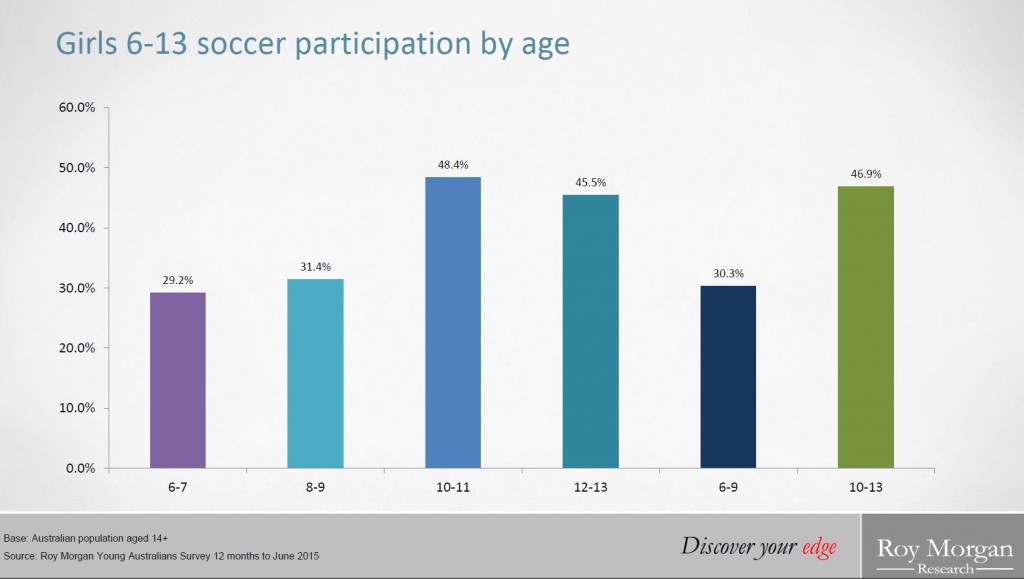 Source: Roy Morgan Research
Source: Roy Morgan Research
This could be attributed to the work done and programs implemented by state federations and clubs to recruit young girls early, at club level or at school.
Further, better engagement with migrant communities by the FFA and organisations like Football United, have seen an increased uptake of football from migrant backgrounds.
Australia's migrant population has long been a source of football participants on the men's side of the game.
However, on the women's side it was a largely anglo-saxon base. That is slowly changing and more girls of Asian, Middle Eastern and African heritage are participating.
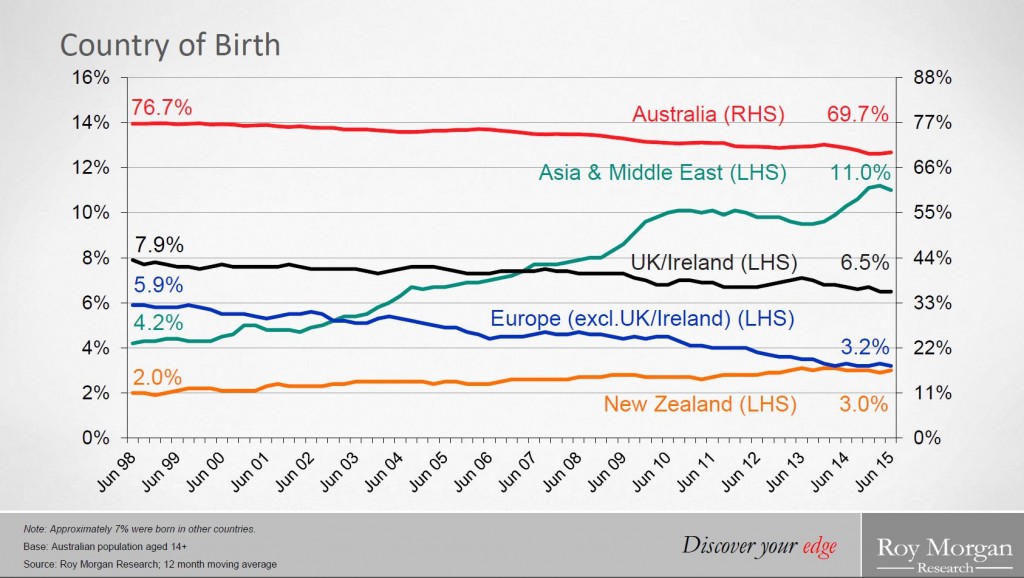 Source: Roy Morgan Research
Source: Roy Morgan Research
While the RMR findings are a cause for celebration, now comes arguably the more difficult part; remaining on top.
Challenges to staying on top
Football may have currently overtaken netball in the 6-13 age group, but the 39% to 37% difference is a small one.
What the figures also indicate is that many girls are playing both sports at that age group and at the next age group - 14+ age group - is where there will be a fierce battle to retain players.
Several studies [1] have highlighted that by 14 years of age, girls drop out of sports as much six times the rate of boys with the trend continuing into adulthood.
Findings provided by RMR demonstrate that the drop out rates in football are not dissimilar.
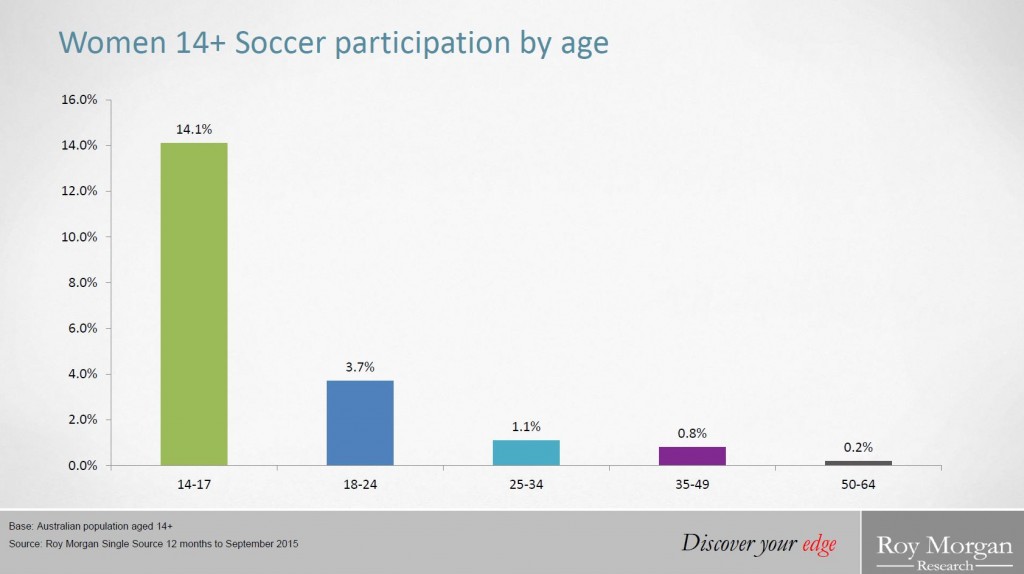 Source: Roy Morgan Research
Source: Roy Morgan Research
Some of the challenges to staying on top are complex and system wide with external factors impacting them. Others are within the sports' control.
Visibility
"You can't be what you can't see."
Continuous (and increased) visibility of elite female footballers (Matildas and W-League) is paramount.
While correlation is not causation, it is significant that many of the big spikes in participation have occurred around World Cup periods, when the national team is most visible.
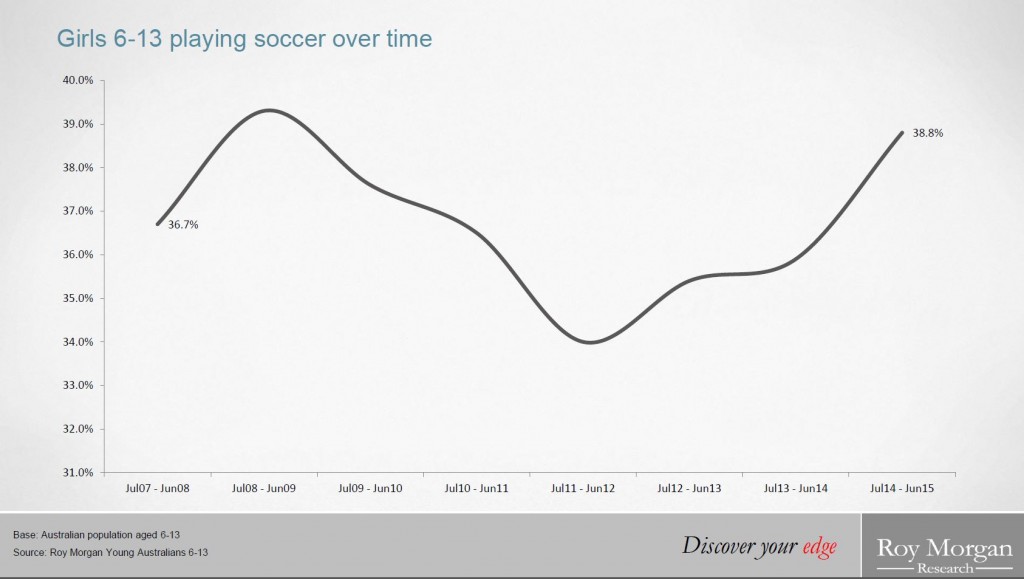 Source: Roy Morgan Research
Source: Roy Morgan Research
SBS's coverage for the 2015 FIFA Women's World Cup was another significant moment with the network providing substantial resources to the broadcasting of the tournament.
The result was win/win for the station - winning "Best coverage of women in sport" at the 2015 Sports Media Awards - and for women's football.
In fact, RMR found there was a "World Cup bump" in the number of women (all age groups) who participate in football "occasionally" [2].
 Source: Roy Morgan Research
Source: Roy Morgan Research
This season the W-League has seen excellent coverage (with strong viewing figures) of the Match of the Round by Fox Sports (simulcast on ABC TV) with a strong female-centric broadcast team.
With increased visibility over the last decade, women's football has become normalised.
For this to continue, the media and marketing of the women's game needs to continue to be driven by the national and state bodies to make it attractive and viable for media organisations.
The challenge will become tougher as the women's sport media market becomes more crowded with netball (ANZ Championship and Diamonds), cricket (women's Big Bash and Southern Stars), basketball (WNBL and Opals), Women's AFL, Rugby 7s and several others all vying for the same limited space.
Opportunities / Pathways
Providing opportunities and pathways for young girls to find success is also key.
At the top end, the brutal truth whispered but rarely spoken aloud is that the elite pathway has been slowly eroding since its initial implementation.
Institute programs have fallen by the wayside, National Training Centre programs have also come under criticism and talent identification is considered to be more haphazard.
One source bemoaned the fact that there were more resources in the previous institute programs in comparison to the state based NTCs resulting in gaps at various age groups for such programs as the skill acquisition programs.
There has also been criticism from several high performance coaches that we have stopped creating environments where the best young players are being challenged by older, experienced players.
It is one of the core issues regarding Football Queensland's decision to make the NPL an under 20 competition.
2014 AFC Women's Player of the Year Katrina Gorry noted:
"By taking away the premier league we are taking away opportunities for young girls to play with and against experienced players and learn from the best in Queensland. How are players meant to develop when they are constantly playing against people the same age?"
Then there is opportunities for rural players beyond the club system.
Other sports have managed to successfully mine and develop the talent away from the major cities. Football used to have this ability but again many feel like that the lack of opportunities for girls in country regions necessitate relocation to major cities.
There are many more issues that can be raised and really a whole series can be written about high performance and the elite pathway.
It will never be perfect but designing and executing programs that feed into a successful national team is important to the overall health of the women's game.
And it is not just about young girls on the elite pathway. As the graph above shows the retention rate continues to drop even further after the age of 17.
Once girls fall out of the pathway what happens to them?
Ideally, clubs should be offering three tiers of football; community football, National Premier League and high performance. It would provide female players with the opportunity to move between the three as they move through their careers.
And what about resources for women who are taking up the game late in life? Then there is the issue of access to grounds and resources (an issue facing football as a whole). Stepping through these issues and formulating sustainable solutions will be vital over the coming years.
Fees
Then there is the question of fees.
Economic factors are always a barrier to entry and football is in danger of pricing itself out of the reach of the very group partly responsible for the increase in girls participation - migrants and the middle class.
In undertaking the below research, football and netball clubs from the same association were selected (although finding information was more difficult in this way), their names have been removed (it is a sportwide issue so shaming serves no real purpose) and clubs were chosen where the fees were the base cost (ie uniforms were a separate fee).
Football
| Age | Group | Ave Fees | |||||
| 5 - 8 | $155.00 | $ 230.00 | $ 210.00 | $ 130.00 | $ 140.00 | $ 100 | $ 160.83 |
| U9 | $180.00 | $ 230.00 | $ 210.00 | $ 130.00 | $ 140.00 | $ 125 | $ 169.17 |
| U10 | $200.00 | $ 240.00 | $ 240.00 | $ 145.00 | $ 170.00 | $ 150 | $ 190.83 |
| U12 | $215.00 | $ 250.00 | $ 240.00 | $ 155.00 | $ 170.00 | $ 175 | $ 200.83 |
| U14 | $225.00 | $ 250.00 | $ 240.00 | $ 155.00 | $ 170.00 | $ 175 | $ 202.50 |
| U16 | $235.00 | $ 250.00 | $ 240.00 | $ 155.00 | $ 170.00 | $ 175 | $ 204.17 |
Netball
| Age Group | Ave Fees | ||||||
| 5 - 8 | $ 50 | $ 55.00 | $ 51.00 | $ 159.50 | $ 80.00 | $ 80.00 | $ 79 |
| U9 | $ 100 | $ 75.00 | $ 51.00 | $ 159.50 | $ 80.00 | $ 120.00 | $ 98 |
| U10 Girls | $ 140 | $ 115.00 | $ 51.00 | $ 170.00 | $ 90.00 | $ 135.00 | $ 117 |
| U12 Girls | $ 140 | $ 115.00 | $ 102.00 | $ 170.00 | $ 90.00 | $ 135.00 | $ 125 |
| U14 Girls | $ 140 | $ 115.00 | $ 102.00 | $ 170.00 | $ 90.00 | $ 135.00 | $ 125 |
| U16 Girls | $ 140 | $ 115.00 | $ 102.00 | $ 170.00 | $ 90.00 | $ 155.00 | $ 129 |
The Leopold Method in a must read article in 2013 outlined some of the reasons for the pricing in football including the 3 tier levy system - national, state and association.
Costs of participation increase again once a player is in the elite pathway [3] and it is a situation that could endanger the retention rates of future players. NSW is taken as the example for comparison.
| Player Registration Fees -– Women’s Football | |||||||
| Comp | FFA NRF | NSW Capitation | Personal Injury Insurance | Gov. Sporting Injuries | Club Fees** | Total (inc. Club Fees) | |
| National Premier Leagues NSW Women’s 1 and 2 | |||||||
| U13 and U15 | $12.60 | $40.00 | $3.53 | $0.77 | $1,443.10 | Up to $1,500 | |
| U 17 | $12.60 | $46.36 | $3.53 | $0.77 | $1,436.74 | Up to $1,500 | |
| Reserve & 1st Grade | $25 | $121.28 | $36.17 | $3.19 | n/a | ||
| Student | $25 | $92.57 | $36.17 | $3.19 | n/a | ||
| Women’s State League | |||||||
| U13 and U15 | $12.60 | $40.00 | $3.53 | $0.77 | $1,043.10 | Up to $1,100 | |
| U 17 | $12.60 | $46.36 | $3.53 | $0.77 | $1,036.74 | Up to $1,100 | |
| Reserve & 1st Grade | $25 | $121.28 | $36.17 | $3.19 | n/a | ||
| Student | $25 | $92.57 | $36.17 | $3.19 | n/a | ||
**The clubs fees also include the NPL competition fee which ranges from $5,115 and $3,155 per club.
Netball Elite competitions [4]
| Comp | Fees
(per player) |
Venue Fees
(per player) |
Total |
| State League | $88.00 | $71.25 | $159.25 |
| State Championships | $24.20 | $71.25 | $95.45 |
| State Youth Age Championships | $24.20 | $71.25 | $95.45 |
| Regional State League | $15.50 | $71.25 | $86.75 |
Netball Levy [4]
| Senior (18+) | Junior (11-17) | NetSetGo! (5-10) | |
| 2014 Fee | $64.00 | $48.36 | $40.91 |
| Proposed 2015 increase | $1.92 | $1.45 | $1.23 |
| Sub Total | $65.92 | $49.81 | $42.14 |
| GST | $6.59 | $4.98 | $4.21 |
| Total | $72.51 | $54.79 | $46.35 |
Again these are a sport-wide issue but one that could potentially negatively impact on future participation rates.
All in all women's football is in the healthiest state it has ever been but that is not to say that there aren't issues and improvements that are needed.
As the saying goes "If you are standing still, you are also going backwards. It takes great effort to maintain forward movement."
[1] Women's Sports Foundation: Factors influencing girls participation in sports
[2] The numbers of those who play "regularly" will usually remain the same as they are registered players in competitions
[3] Football NSW: NPL and State Leagues Competition Registration Fees
Related Articles
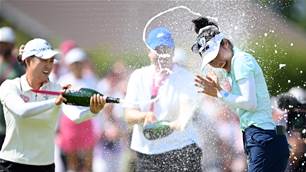
Column: Back-to-Back and Better Than Ever

The Aussies at the U.S Women’s Open
